Part 1, in SAR’s October, 2010 issue, was an overview of MARSOC’s mission, structure and activities. In this concluding installment, we take a close look at how Marine Critical Skills Operators and other essential personnel are trained for high-stakes missions in what we stubbornly insist on calling the Global War On Terrorism.
MARINE CORPS SPECIAL OPERATIONS COMMAND
Part 2: Training SOCOM’s Devil Dogs
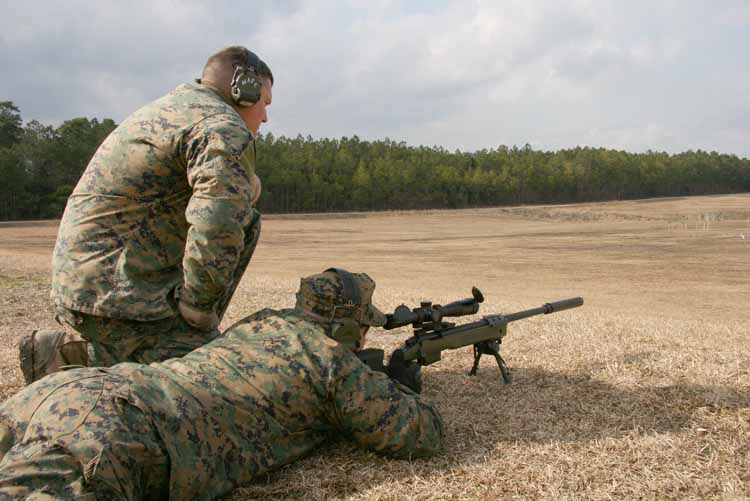
Special Report by Robert Bruce
“Don’t underestimate your enemy. They know the land and spend all day preparing to kill you. Whenever you’re tired of training and rehearsing, ask yourself if the enemy is resting.” Sergeant Matt Yohe, Instructor, MSOS Advanced Sniper Course.
Sgt. Yohe speaks with authority based on personal experience from months of serious operations as a MARSOC sniper with the Combined Joint Special Operations Task Force – Afghanistan against hardened Taliban forces fighting on their home turf. This tall and rawboned 29 year old fits most anyone’s idea of a battle-hardened Marine, the product of eight years in the Corps’ most hard-charging units including 2nd Recon Battalion before his assignment to 2nd Marine Special Operations Battalion
He also typifies the quality of the combat experienced Marine operators who are hand-picked for instructor duty at Marine Special Operations School. According to MARSOC sources, they come from Marine Special Operations Teams after two deployments or more, and are nominated by their Battalions.
SAR met and talked at some length with Yohe and several other instructors during our visit in late February to MSOS, MARSOC’s “Schoolhouse” at Camp Lejeune’s historic Stone Bay. These NCOs are an impressive lot who exemplify the right stuff by appearance, demeanor and no-nonsense interaction with outsiders.
Victoria per Scientiam
Marine Special Operations School is a regimental level command, formally activated in June 2007 but already operational months earlier.
Its distinctive unit crest evokes the heritage of WWII Marine Raiders in a blue shield emblazoned with five stars, an iconic Fairbairn-Sykes stiletto fighting knife and a motto in Latin that translates to “Victory through Knowledge.”

Most of its initial training cadre was composed of elements transferred in from the Special Missions Branch of the Marine Expeditionary Forces Special Operations Training Group. These skilled and savvy Marine trainers are credited in large part with the amazingly short period from MARSOC’s creation to its first elements being certified by U.S. Special Operations Command as fully mission capable.
MSOS, informally known as the “Schoolhouse,” screens, assesses, selects and trains Marines and Sailors for Special Operations assignments in MARSOC; provides advanced individual special operations training; plans and executes the component exercise program. It serves as MARSOC’s training and educations proponent and is the link between MARSOC, USMC and SOCOM component SOF schools. Additionally, it develops MARSOF standards, doctrine and TTP (Tactics, Techniques and Procedures), and serves as MARSOC’s proponent for weapons and optics requirements
MSOS is organized with a Headquarters Company and five branches, each responsible for specific taskings that are critical to MARSOC’s wide-ranging missions:
- Assessment and Selection Branch is the entry point for personnel seeking to come aboard MARSOC.
- Personnel Recovery/SERE Branch specializes in training programs that maximize survival, evasion, resistance and escape skills.
- Exercise Control Branch develops and executes complex and ever-changing scenarios that challenge and validate mission readiness for MARSOC elements; notably the Marine Special Operations Battalions from teams to tailored task forces.
- Language Branch teaches a wide range of tongues native to locations worldwide from Arabic to Urdu, with emphasis on those common to areas of particular interest to U.S. Special Operations Command.
- Special Operations Training Branch conducts ITC (Initial Training Course) for NCOs and company grade officers who will be assigned as “operators” (properly known as CSOs – Critical Skills Operators) in the Marine Special Operations Regiment and it’s the home for Special Operations advanced and specialty courses
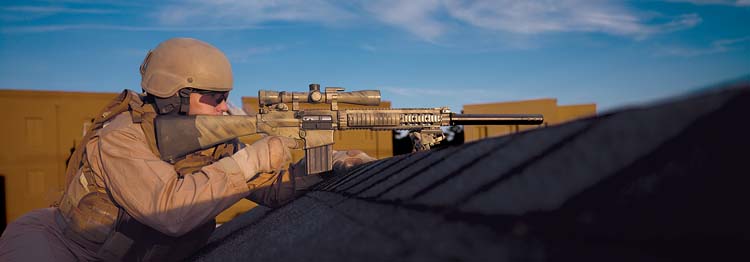
Initial Training Course
The focus of our visit to MARSOC’s Schoolhouse was Special Operations Training Branch, currently housed in an orderly formation of a dozen or so modular classrooms while construction is underway nearby on a more traditional campus. There, Lieutenant Colonel Clark Watson, SOTB’s Director, walked us through the high points of the Initial Training Course, a comprehensive SPECOPS basic training program that is the next step following Assessment and Selection for those seeking to become CSOs.
It’s broken down into four phases of instruction, practice and evaluation, Watson explained, that require learned skills to be applied under increasingly adverse conditions.
As can be expected, students who have already demonstrated high levels of physical and mental toughness as an entry requirement are pushed much further in the first phase. Escalating challenges include endurance, functional fitness and highly aggressive combatives.
During these first few weeks of long hours with heavy physical and mental stress, some otherwise “gung-ho” CSO candidates are likely to question if they have the right stuff for the job. This is, of course, exactly as it must be.
We’re told that amphibious training is often the most difficult for many otherwise tough and capable Marines. Combat Water Survival Level Two is a prerequisite, but Watson emphasized that the realities of training for waterborne warfare require significantly higher capability.
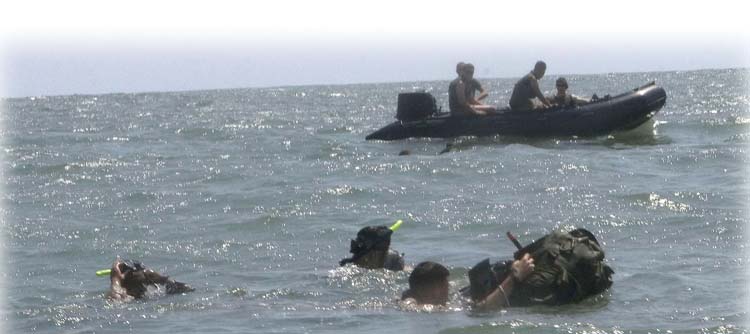
The Assessment and Selection Preparation Guide emphasizes that swim requirements are done in utilities (fatigue jacket and trousers) but aspirants get a break by shedding their boots. There’s an “abandon ship” drill requiring a leap into the water from a six meter high platform, a 300 meter swim, ten minutes of treading water, and five minutes of survival float.
But that’s just to get in. It gets harder and harder in preparation for the course’s amphibious exercises.
Watson also explained that the current class was only the third under the ITC designation and the curriculum had undergone some changes based on input from various sources including student evaluations, operational realities and other factors. Also, because ITC is open to Marines in all MOSs (Military Occupational Specialties), the first part of the course acts as a sort of abbreviated and intensified version of the Marine Corps’ School of Infantry.
While careful to avoid revealing too much detail, Watson listed many of the tasks that must be mastered to earn the coveted “operator” designation.
Basic field skills like land navigation, pistol and carbine marksmanship, individual and small unit tactics, patrolling, and casualty care are strongly reinforced. A necessarily harsh dose of Survival, Evasion, Resistance, and Escape (SERE) is required, along with some classroom work on USSOCOM’s unique Joint Planning Process.
Physical demands ramp up along with academic rigors, combining to identify early in the course students who are unlikely to make the grade. Those who voluntarily leave or are dropped for academic failure return to their previous assignments without adverse entries in their official records. If injuries or other waiverable factors are noted, there is a second chance and they can plug back in where they left off in subsequent courses.
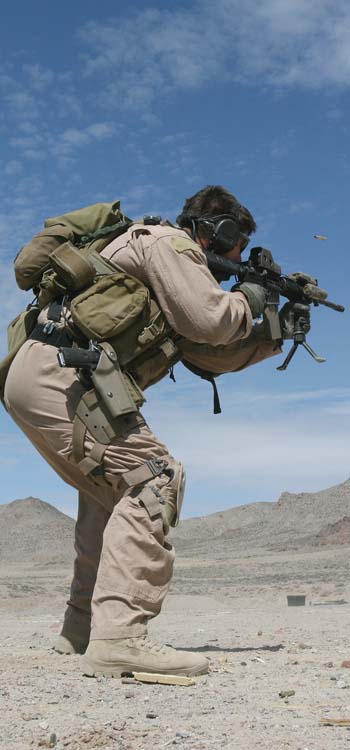
As the weeks grind on the challenges become even more complex. There’s mission planning, special reconnaissance, more combat marksmanship with emphasis on CQB (Close Quarter Battle), amphibious operations, and Demolitions. Communications is critical, requiring mastery of satellite communications, high frequency radios and data systems.
Interestingly, the foreign weapons block of instruction in previous versions of ITC has been cut back, reportedly due to time constraints in the packed curriculum. Now, only the AK family of assault rifles – the most commonly encountered in the world – are included in classroom training and familiarization firing. Other foreign weapons training can wait until after graduation and assignment to the Marine Special Operations Regiment.
Colorfully named, structured tactical exercises mark transition periods in each phase. Guile Strike is five days of close quarter battle from insertion to hit on target, Stingray Fury is an eleven day special reconnaissance mission and Raider Spirit tests students in patrolling, raids and recon over twelve days.
Derna Bridge
All of this (and a lot more that is not publicly revealed) builds rapidly and steeply toward a final exercise keyed to MARSOC’s Irregular Warfare mission.
Everything in the course comes together with the three week long operation Derna Bridge, named in honor of what was arguably the first Unconventional Warfare operation in U.S. history. It was in 1805 that Marine Lieutenant Presley O’Bannon led Marines and foreign fighters in a successful attack on a strategic harbor fort in Tripoli, the first time that the U.S. flag was raised on foreign soil.
ITC’s Derna Bridge forces students to use all of the skills mastered throughout the course while training, advising and operating with role-players realistically portraying a Partner Nation/Irregular force.
A sobering indication of the difficulty of this final exercise and the uncompromising standards of the course as a whole may be found in noting that fifty students in the class prior to our visit made it as far as this final exercise but only forty graduated.
We have subsequently learned that, beginning in June, the increasing demand for CSOs will be met by overlapping ITCs with the goal of qualifying up to 144 operators per training year.
Follow-On Training
After graduation from ITC most are assigned to the MSO Regiment where these newly-minted operators continue a variety of live fire exercises to maintain a level of precision marksmanship with their M4 primary and M45 secondary weapons. They also train to be proficient in the use of all organic MSO Team weapons as well as the non-U.S. weapons used by friendly and hostile forces where they are expected to deploy.
MSOS offers advanced-level courses for qualified operators in a number of subject areas including Special Reconnaissance, Close Quarters Battle, Sniper, Breaching, and Weapons Employment
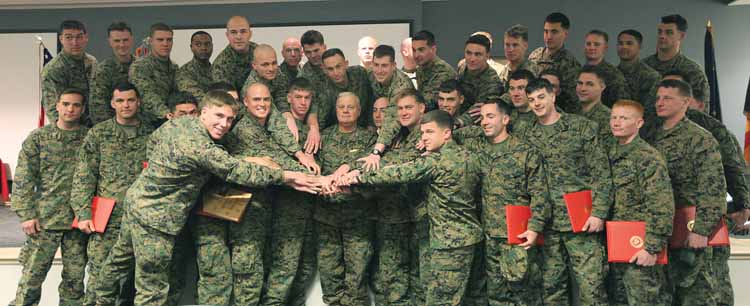
All MARSOC Marines are required to undergo continual language training. However, based on ability, certain Marines will be selected for follow-on language training at an Advanced Linguistics Course.
While Support Group personnel who deploy with MSO Teams to provide specialized capabilities have previously trained in many of the topics taught at ITC, MSOSG has created a demanding 22 day Special Operations Training Course. Now, Combat Support Marines in Intel, K-9, Commo and other MOSs get a concentrated dose of war fighting craft with plenty of instruction and trigger time in weapons from 9mm pistols to .50 caliber machine guns. They also gain a working knowledge of land navigation, radioing for fire support, casualty care, and many other combat skills that help them integrate with CSOs as valued members of MSO Teams.
Weapons of MARSOC
Aside from the M45 MEU-SOC pistol, an exclusive badge of honor for CSOs, most everything in use by MARSOC operators and others is standard Marine Corps stuff. The laundry list of “tools of the trade” includes:
* 9mm M9 Pistol
* .45 cal. M45 Pistol
* 5.56mm M4A1 And SOPMOD Carbine
* 40mm M203 Grenade Launcher
* 5.56mm M249 Squad Automatic Weapon
* 7.62mm M240 Medium Machine Gun
* .50 cal. M2HB Heavy Machine Gun
* 7.62mm M39 (M14) Enhanced Marksmanship Rifle
* 7.62mm MK11 Semiautomatic Sniper Rifle
* 7.62mm M40 Sniper Rifle
* .50 cal. M82/M107 Special Application Scoped Rifle
* 12 gauge M1014 Joint Service Combat Shotgun
* 12 gauge M870 and M500 series Shotgun
* 40mm MK19 Grenade Machine Gun
* 40mm MK47 Grenade Machine Gun
* 60mm M224 Lightweight Mortar
* And, as cryptically stated by MARSOC, “other weapons as required by the mission”
Weapons and Tactics Roundtable at SOTB
We were privileged to be given the opportunity to meet with a group of MARSOC Marine NCOs who specialize in weapons and tactics instruction at Special Operations Training Branch’s ITC. All of them are seasoned operators with combat experience, some with several deployments, and each one hand-picked to come to the Schoolhouse.
Accepting our promise that what was said would be accurately reported with no names attached, the informal roundtable discussion yielded a wealth of highly interesting and undeniably credible observations. These Marines have a clear vision of what works in the real world and what they think needs improvement among the standard issue weaponry in MARSOC’s armory. What follows is to be taken as PERSONAL opinion, NOT official endorsement or criticism.
They rate the 5.56mm M4 series carbine as a “good weapon but needs improvement” to increase reliability in adverse environments. One instructor underscored this by recounting a personal experience of his M4A1 “jamming at the worst possible time” during a firefight. The SOPMOD version (also used in MARSOC) is a step in the right direction, he said, but all agreed that replacement of its direct gas system with a piston is urgently needed. The relatively simple and inexpensive substitution in their standard issue M4A1’s upper with the right piston kit would meet their approval.
Several of these Marines had a hand in MSOS’ recent evaluation of the FN SCAR – not coincidentally a piston driven design – and their report up the chain of command listed more likes than dislikes in its overall form and function. The piston powered HK416 has also undergone some trials so it may be inferred that some change may be in the wind. Not likely a wholesale changeover, they said, but any new carbine/rifle would be used in specialized situations as a supplement to existing M4A1s.
While on the subject of 5.56mm weapons it was said that the standard issue green-tip M855/SS109 ammo’s tendency to over-penetrate in soft targets is problematic. Before a lively discussion of alternative calibers could overwhelm the available time, we learned that a quantity of the new MK318 cartridges is on hand for evaluation. Perhaps a step in the right direction in terms of stopping power, but some skepticism over accuracy was noted around the room.
They like the 5.56mm M249 SAW for its portability, versatility and high volume of fire. Asked about persistent problems outside the SPECOPS community with hard-used guns and their old and worn innards, the roundtable consensus was favorable toward reliability of their own guns. They saw no need to replace the current SAWs with FN’s MK46 or other designs.
This begged our question of belt fed 7.62mm guns, particularly in light of MARSOC’s standard M240 that some call an uneasy tradeoff between heavy weight with high reliability vs. man-powered portability. Not surprisingly, another serious discussion ensued where the combat utility of 5.56mm vs. 7.62 belt guns was contrasted. Heads nodded around the room when M60E3s and MK48s were noted for their compactness and light weight. But, while acknowledging the case made by “higher-ups” for the long reach and potent target effects of the 240’s rifle caliber cartridges, these muddy boots Marine operators say they prefer the lighter, handier 5.56mm M249 SAW in nearly all dismounted applications.
SAR believes the oft-spoken truism that “pistols are intensely personal,” and noted with great interest when the instructors pointed with pride to the superiority of MARSOC’s M45, a modified M1911 series .45 cal., over the 9mm Beretta M9s used by most of the Marine Corps. Perhaps acknowledging the practical arguments for various combat calibers from .40 and up, one declared, “Don’t go to war with anything that doesn’t start with point 4.”
Their potent .45s are based on Marine Force Recon’s tried and true MEU (SOC) pattern from Quantico’s Precision Weapon shop. They are readily identified by their distinctive beavertail safety, light mounting rail on the frame and extra cocking serrations on the front end of the slide. We learned that some, custom made by the commercial firm Springfield Armory to MEU (SOC) configuration, have been fielded.
A discussion of the many merits of this heavy-hitting slim line single-stacker was clouded by another “intensely personal” anecdote. General agreement was evident as one instructor pointed out from much experience that John Browning’s venerable design is also vulnerable to invasion of environmental elements like mud and sand. So, we asked, what would you recommend instead? Before things got completely out of hand a good case was made for some Glocks that have somehow made their way into the Schoolhouse’s armory. Said to be tough, simple, reliable, and effective, these angular, polymer frame pistols also find instructor favor as being quite suitable for concealed carry when required by circumstances….
Room for improvement was clearly stated regarding MARSOC’s main 12 gauge shotgun, the same Benelli M1014 that is standard issue throughout the Marine Corps. At the same time acknowledging the utility of its semiautomatic operation for quick-firing multiple buckshot and slug rounds, one instructor recalled experience as an operator in combat. “I’d rather have an 870 (Remington 12 gauge pump),” he said. “You don’t need to put it on safe when you fire a round then transition to your M4.” It was also mentioned that the M1014 won’t automatically cycle with frangible lockbuster rounds and doesn’t come in a handy no-buttstock version with stubby barrel that’s favored by many Breachers.
With the available time running out we asked why some ITC students were failing to meet the course’s shooting standards. With “every Marine a rifleman” and all students coming from the ranks of seasoned Marines with plenty of range time, what was the problem?
One instructor jumped right in with the answer, “We’re not teaching marksmanship in ITC, we’re teaching CQB (close quarter battle).” The difference, he explained, is more like gun fighting where moving and shooting at briefly glimpsed targets is a world apart from what most Marines learn in Boot Camp and reinforce in periodic re-qualification firing. “Unfortunately,” he said, “some students have a lot of trouble adapting to the high stress and special skills needed.”
We put specific questions regarding FN SCAR rifles, MEU-SOC M45 pistols and related issues through MARSOC’s command structure. The responses were surprisingly candid. “MARSOC is currently divesting from the SCAR-L (MK-16), which means they are being turned back into Crane and MARSOC will not pursue acquiring this weapon. The SCAR-H (MK-17) and SCAR-EGLM (MK-13), MARSOC is keeping a small quantity to employ as an augment to the current service rifle and grenade launcher. It will be assessed if this capability is required for additional weapons in the future.”
SAR: Are any other new weapons (Glock vs. M1911), optics, ammunition (MK318, etc.) likely to be adopted?
“MARSOC is currently working with the Marine Corps on a replacement for the M-45 (aka MEU-SOC 45). MARSOC is continuing to utilize the SOPMOD accessories (i.e: optics, aiming devices), the new sight is the grenade launcher sight for the M-203 that is being tested by both SOCOM and the Marine Corps. The Marine Corps is conducting testing on AB49 (MK318) ammunition as a replacement for the current 5.56mm round.”
There you have it, right from the source.
Meet Some MSOS Instructors
In addition to the briefing by Lieutenant Colonel Watson and several informal discussions, SAR got answers from three of the Schoolhouse’s instructors to a series of questions submitted in advance of our visit. We met on Stone Bay’s storied Hathcock Range (namesake of Marine sniping legend Carlos Hathcock) in between some very long range firing exercises that were part of the Advanced Sniper Course.
Comments that follow are from Staff Sergeants Nicholus Blackmon and Jason Salvog, along with Sergeant Matt Yohe. Blackmon is a native of Villa Rica, Georgia, with ten years of service in the Corps and 18 months at MSOS as a weapons instructor. Salvog also has a decade of service as a Marine and the last three years at MSOS as a tactics instructor. Yohe has been a Devil Dog for eight years and recently chosen as an academics instructor for MSOS’ Advanced Sniper Course (MASC).
SAR: Why did you join the Corps? Why did you ask for assignment to MARSOC and MSOS?
Blackmon: Three things I enjoyed while growing up in the backwoods of Georgia were hiking, camping and hunting. So, at the end of my senior year in high school I started looking at the military. The Marine recruiter was a standout and I enlisted in the Corps. I was attending the Small Arms Weapons Instructor Course at Quantico in 2005 when I learned that my unit of assignment was disbanding. Senior leaders urged me to try out for a new unit called MARSOC and I was accepted into the Foreign Military Training Unit (now 3rd MSOB). I’m happy that I made the move. I did three deployments with my team and after the last one I was assigned to MSOS. Because of my background and training in small arms, I was assigned to the weapons section.
Salvog: I figured I’d go into the military at some time, and after a couple of years of college, it seemed like the right time. I chose the Marine Corps. I’ve always liked a challenge and that’s why I decided to come to MARSOC and was assigned to India Company of 2nd MSOB, then MSOS.
Yohe: My father was a Marine. I’ve served in the Sniper Platoon of 3rd Battalion, 6th Marine Regiment, 2nd Recon Battalion, and now MSOS. I asked to come to MARSOC for the opportunity to challenge and improve myself while serving my country.
SAR: Has your current assignment lived up to your expectations?
Blackmon: In one word, yes. As an instructor I not only get to see and test (possible) future weapons, I have the opportunity to have a direct impact on the future warriors of MARSOC.
Salvog: My current assignment has been good. I’ve finally gotten some time off to see my family and help my wife with our kids. I’ve also gotten to teach sniping; something I’m passionate about.
SAR: Are you personally interested in firearms and shooting? Describe your interest and tell us about your preferences in privately owned weapons.
(This question hit a thick gold vein and between the three Marines they own more than a dozen rifles, shotguns and pistols. Precision rifles topped their lists, notably Yohe’s McMillan TAC-338, and all have customized variants of the AR-15 platform in 5.56 or 6.8mm. Several versions of M1911 series pistols are also in their personal armories.)
SAR: What formal schools and subsequent training – particularly firearms related – have you received for your duties?
Blackmon: I’ve attended several firearms training schools. I’m a graduate of the USMC’s Small Arms Weapons Instructor Course and Foreign Weapons Instructor Course. Also Blackwater and Bill Rodgers on the civilian side.
Salvog: Scout Sniper Basic Course, Advanced Sniper Course and CQB (Close Quarter Battle) package to help improve my shooting skills and refine different tactics now in use.
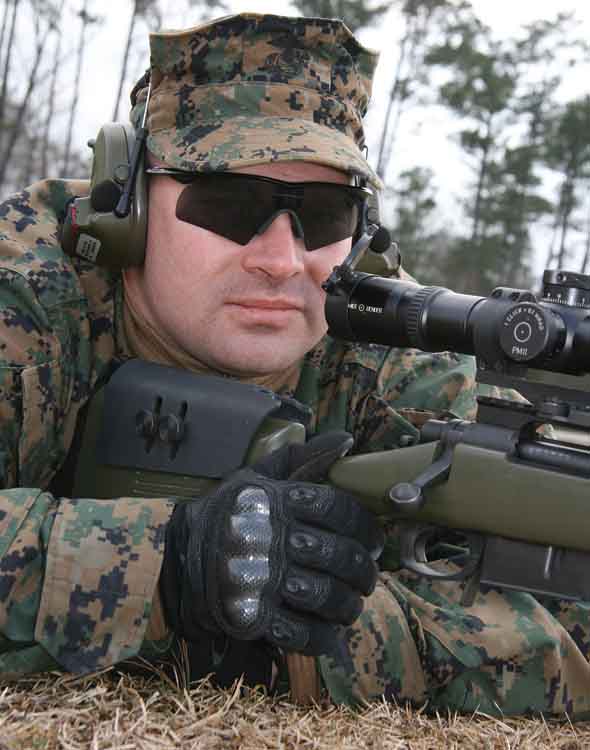
Yohe: Scout Sniper Basic Course, Mountain Sniper, McMillan Warfighter Sniper Course, MARSOF Advanced Sniper Course (twice), Accuracy First, and several others.
SAR: Do you believe you had adequate training time to prepare you for the realities you experienced in previous deployment and in assisting your current assignment?
Blackmon: Adequate? I’d have to say yes. With deployments, you can only train to a standard that will put you as close as possible to a combat situation. The best thing we can do to prepare ourselves is to not only have a great understanding of the weapons systems we take into combat or on deployment. We should have thorough knowledge of the weapons used by partner nations and our enemies. This is a concept that the weapons instructors (at MSOS) try to impart to the students who will be future MARSOC operators.
Salvog: I’ve had good training time and experience to help me fill my role as an Advanced Sniper Course instructor. Utilizing my different skills on deployment and being able to refine them from the training environment to the real world has helped me pass on my experiences to the students.
Yohe: Adequate, at best, live fire practice prior to deployment. The problem being the amount of training required in the workup before deployment and the amount of time allotted…you could always use more trigger time.
SAR: What recommendations would you like to make to the chain-of-command to improve operator skill with crew served and individual weapons?
Blackmon: For crew-served, students need to get a base line introduction to light and medium machine guns before attending follow-on training. The student is immersed in a wealth of knowledge on currently issued individual weapons. I recommend more time with the student to develop more than just a base line understanding.
Salvog: The biggest problem with the training that students receive on the crew served weapons is that they don’t get enough time to become proficient prior to deployment. (That comes) after they’re in-country and having to use them. We didn’t even see the (deleted) until we were in-country.
Yohe: Maintain high standards. If someone can’t shoot, you don’t want that person behind the gun, whether it’s when you’re making entry into a house or on your overwatch.
SAR: What are your observations on the crew-served weapons in current use by MARSOC?
Blackmon: The most commonly used crew-served weapons are the M240 machine gun and the 60mm M224 mortar. While not doctrinally considered crew-served, there is also the M249 SAW. As with any weapon system, their reliability is based on the operator. Did he perform pre-fire inspections? Does he maintain it by cleaning and proper lubrication? The great thing about our light and heavy machine guns is the volume of fire they can deliver in a firefight. The 60mm mortar adds a great indirect fire capability to the team or company. It can be used to provide illumination at night or to cut off evading forces that might have tried to attack or ambush U.S. forces. If MARSOC decides to transition to the Special Operations weapons such as the MK46 series machine guns and the MK47 grenade machine gun, a lot of issues that come up with the standard issued crew serves will be addressed.
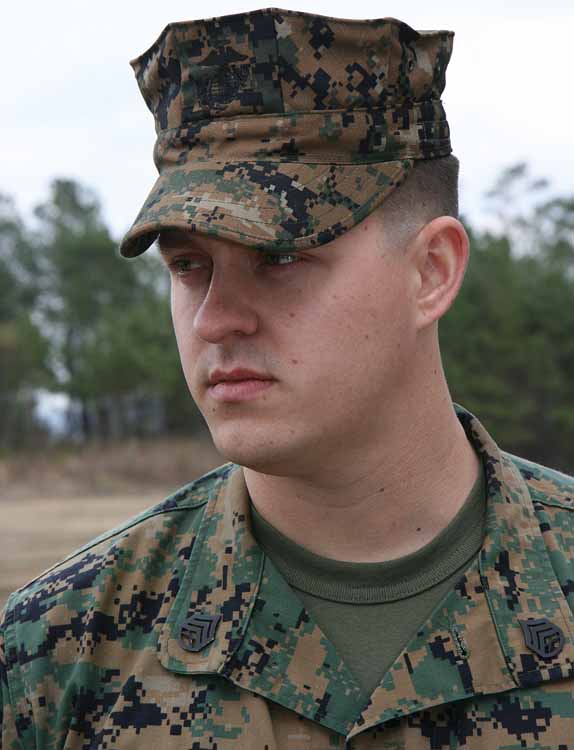
Salvog: Some of the big problems we saw with the crew-served weapons are keeping sand out of them while traveling down the road or across the desert. Some, mostly the M240s, once they did get sandy they’d single shot rather than working properly. Most of the big guns like the 40mm MK19 and MK47, and the .50 cal. M2HB, had minimal problems.
(Note that sniper rifles are normally utilized by a two man team consisting of a shooter and a spotter. As such the Marine Corps considers them to be crew-served)
Yohe: The current generation of bolt action rifles are predominantly chambered in the standard .308 caliber. Unfortunately, this round is lacking in our current combat environment. There are projects in the works to field a new caliber with the ability to engage targets out to 1,500 meters with enough energy at that range to still have the desired effects on a target. For some reason, there are a lot of people who feel the .300 WinMag will suit that role. It is an improvement over the .308, however, there are better rounds out there that will pack a hell of a lot more punch and won’t be trans-sonic at that 1,500 meter mark. Plenty of other units around the world already transitioned to the .338 Lapua Magnum round, well known for its long-range capabilities. I think it would be the best round for the job.
SAR: What’s the greatest challenge in keeping these weapons maintained and ready under difficult conditions and what “tricks of the trade” have you learned from real-world experience that may not be in official doctrine?
Blackmon: The operator’s greatest challenge is keeping his weapon functional no matter where he deploys. Since MARSOC deploys teams all across the globe, this is a challenge for the instructor cadre. We use a base line maintenance program that includes information for operating in different climates. A tip I give my students is to think of your weapon as a car you’re taking to a car show. You don’t want to show up with one that’s covered in rust and won’t crank.
Salvog: Some of the tricks we use for the crew-served is to have bags or cloth sleeves bungee corded around the feed tray and ejection port of the 240s and to minimally lube the others.
Yohe: My tricks stay with me and my students.br>
SAR: And your comments on MARSOC’s individual weapons?
Blackmon: MARSOC issues the M4A1 carbine to its operating forces, along with the SOPMOD (Special Operations Peculiar Modification) kit. The M4A1 has a variety of setbacks compared to other standard issue weapons of other countries. This weapon requires a disciplined and meticulous maintenance cycle that the operator has to perform to ensure his weapon is functional.
Salvog: For the most part our individual weapons worked well. We did have some springs and triggers break on our M1911. But for the most part, the M4s, M40A3, MK11s, and M107s worked fine.
SAR: Comment on any “wish list” for accessories, etc. that you believe would improve the effectiveness of any of the standard-issue crew-served and individual weapons.
Blackmon: One item I would personally like to see changed is the gas system on the M4A1. I believe that a gas piston system like the one found on an AK series rifle or the MK16 SOF Combat Assault Rifle (FN SCAR) would greatly improve the effectiveness of the weapon.
Salvog: I’ll keep it short as this could take up a whole page easily. There were a couple of missions that a MK15 (McMillan TAC-50) would have been an asset due to its better accuracy than the M107. MK13s (Accuracy International L115-A1) would have been an asset due to their increased range and flatter trajectory.
Yohe: All things in the combat arms industry evolve. People who deny the need for change should try to fight the Taliban with a muzzle loader. There are plenty of people around the R & D community who have illustrated the great points of the Horus Vision line of (rifle scope) reticles. We use scopes equipped with the Horus Vision reticle exclusively here at our course. This product needs to be taught and utilized by scout snipers across the Marine Corps.
SAR: To the extent allowed, describe your most recent foreign deployment in support of the Global War on Terror (“Overseas Contingency Operations”).
Blackmon: My last deployment was to Central Command Area of Operations, training the forces of partner nations in small arms employment, patrolling and basic land navigation.
Salvog: Most recently to Afghanistan as part of Marine Special Operations Company I, Team 2. A couple of firefights, most notably when we got hit during extraction. We were taking fire from across the valley and I was trying to suppress with a medium machine gun. After the first couple of bursts by both of us it became too smoky and dusty for me to accurately engage with my night vision device. I had to have someone on a roof adjust my rounds to put me on target. This is an instance when a good thermal sight would have come in handy.
Yohe: I participated in special operations for Combined Joint Special Operations Task Force – Afghanistan from September 2008 through March 09.
SAR: What lessons did you learn about yourself, your fellow MARSOC operators/instructors, etc., as a result of your deployment experiences?
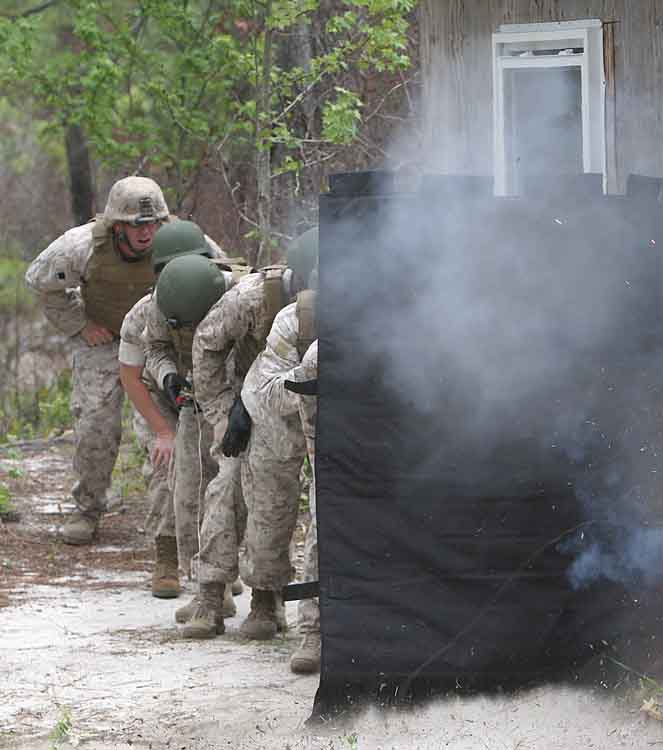
Blackmon: One thing that really stood out from the last mission is that not every operator makes a great instructor. Just because someone has a wealth of information on a particular subject doesn’t mean he knows how to convey it in a platform instructor type environment. Couple that with having to teach the info in a foreign language or through the use of an interpreter can create a lot of stress.
Salvog: It would be beneficial for commanders to get a good brief on what the capabilities are for each individual school and training that the team has received.
Yohe: The human body is capable of extraordinary feats when pushed; whether it’s surviving wounds or in great feats of strength.
SAR: What advice do you have for MARSOC operators preparing for their first deployment?
Blackmon: Know and understand your mission as well as the culture you are going to. Know the weapons you are taking and those commonly found in your area of operation. Study the language, customs and courtesies of the area. Sometimes a handshake and a smile will go a lot further than one well placed shot.
Salvog: Get as much training as you can, listen to your Element leaders, Operations Chiefs and Team Chiefs. Make sure you bring gear to cover the full spectrum of what you could possibly be doing.
Yohe: Don’t underestimate your enemy. They know the land and spend all day preparing to kill you. Whenever you’re tired of training and rehearsing, ask yourself if the enemy is resting.
SAR: What would you like to say to young men considering joining the USMC about why they should strive for assignment/acceptance in MARSOC?
Blackmon: As a Marine you should always strive to be the best no matter what function you perform in the Corps. MARSOC is the field that allows you to play at a whole new level. You will be challenged nonstop both physically and mentally. And if you try out for MARSOC you should know that special operations is not for everyone. It takes a certain type of personality to complete Assessment and Selection, Individual Training Course, and to move on to be an effective member of a Marine Special Operations Team.
Salvog: If you want to challenge yourself, be proficient in numerous skills and have the intestinal fortitude to stick it out, then give it a shot. If not, there are many other necessary jobs in the military.
Take the Challenge: Courtesy of MARSOC
(Editor’s Note: All of this information and more may be found on MARSOC’s extensive website www.marsoc.marines.mil. Because many of the Marines and Sailors among SAR’s readership may be deployed to “austere” locations with limited or no internet access, we’ve provided a full printout of this section.)
Specialized missions require not necessarily the best, but the “right” type of Marine. MARSOC needs applicants who not only possess many leadership traits, but also demonstrate effective intelligence and a mental agility to solve complex problems under stress. Since MARSOC often operates in austere and remote environments and comes in contact with people of different cultures; adaptability, determination, physical ability, interpersonal skills, and working well in a team, are also key.
Assessment and Selection (A&S)
All billets in MARSOC require unique training, offer the potential for worldwide deployment and direct participation in combat operations. However, at this time, only CSO applicants are required to attend A&S.
Once a Marine is qualified through the screening process, he will be invited to attend an A&S. A&S is a mentally and physically challenging evaluation held five to six times a year at an undisclosed location. The 19-day assessment enables instructors to identify Marines with the necessary attributes to complete follow-on special operations training and to conduct special operations missions. A&S is highly competitive. While our recruiters can provide potential candidates with a recommended training guide designed to physically prepare them for the rigors of the selection process, it is the applicant’s responsibility to ensure that they are ready to meet the challenges of A&S.
Selection at A&S is valid for a member’s career barring any disqualifying circumstances (adverse fitness report, courts martial, etc.) that may occur between selection and assignment to MARSOC. Marines not selected for assignment to a CSO billet through A&S will not be assigned to an operational billet within MARSOC. Depending on the circumstances, Marines who are not selected may be invited back to attend another A&S.
SAR extends special thanks to MARSOC’s Public Affairs Office for exceptional assistance in arranging interviews and photo opportunities during our visit, then following up with much additional information and graphic elements.
Find Out More
www.marsoc.marines.mil
Marines and Sailors interested in joining MARSOC are encouraged to call MARSOC Recruiting:
East Coast and Okinawa (910) 451-0099/3349
West Coast and Hawaii (760) 763-5101/5102
| This article first appeared in Small Arms Review V14N3 (December 2010) |










